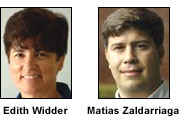
2006 MacArthur Fellows Announced
CHICAGO, Sept. 19, 2006 -- A deep-sea explorer and biologist who specializes in bioluminescence and a theoretical astrophysicist who analyzes faint signatures of the Big Bang to piece together the early history of the cosmos were today named 2006 MacArthur Fellows, two of this year's 25 recipients who will each receive $500,000 in "no strings attached" support over the next five years.
 The John D. and Catherine T. MacArthur Foundation is a private, independent grantmaking institution dedicated to "helping groups and individuals foster lasting improvement in the human condition." In naming the MacArthur Fellows for 2006, the Chicago-based foundation said all were selected for their creativity, originality and potential to make important contributions in the future.
The John D. and Catherine T. MacArthur Foundation is a private, independent grantmaking institution dedicated to "helping groups and individuals foster lasting improvement in the human condition." In naming the MacArthur Fellows for 2006, the Chicago-based foundation said all were selected for their creativity, originality and potential to make important contributions in the future.
Edith Widder, co-founder and director of the Ocean Research and Conservation Association (Ocean Recon) in Fort Pierce, Fla., combines expertise in oceanographic research and technological innovation with commitment to reversing the worldwide trend of marine ecosystem degradation. She helps to design and invent new submersible vehicles, instrumentation and equipment to enable unobtrusive deep-sea observation of environments.
Working with engineers, she has built a number of unique devices that enable scientists to see the ocean in new ways, including HIDEX, a bathyphotometer that measures how much bioluminescence (the light chemically produced by many ocean organisms) there is in the oceans, and LoLAR, the most sensitive deep-sea light meter.
Most recently, Widder helped to design a remotely operated camera system, known as Eye in the Sea (EITS), which, when deployed on the sea floor, automatically detects and measures the bioluminescence given off by nearby organisms. EITS has produced footage of rare sharks, jellyfish and squid in their natural habitats.
A key effort of Ocean Recon is the development of state-of-the-art sensors and technological systems for evaluating water quality and ecosystem health. While translating complex scientific issues into engineerable solutions, Widder is fostering greater understanding of ocean life as a means to better, more informed ocean stewardship, the foundation said in naming her a Fellow.
Matias Zaldarriaga is a theoretical astrophysicist and professor at Harvard University in Cambridge, Mass., who analyzes faint Big Bang signatures to understand the history of the universe. Early in his career, Zaldarriaga co-wrote computer software known as CMBFAST that has become a standard tool for astronomers interpreting observations of the cosmic microwave background (CMB); it has been used to estimate the total density of mass and energy in the universe.
His analyses reveal the power of CMB observations such as lensing and polarization to generate gravitational maps of the early universe and for exploring indirectly the properties of otherwise undetectable matter in the intervening space. Zaldarriaga has also identified interpretive pitfalls in analyzing experimental data; his insights have a direct impact on the design of telescopes that are currently being constructed.
Recently, he and his colleagues argued that the period after the Big Bang but before the formation of the first stars could be indirectly observed by examining variations in CMB at the 21-cm wavelength. This proposal may offer an experimental window into events that previously were only matters of conjecture.
For more information on the foundation and this year's Fellows, visit: www.macfound.org
Published: September 2006